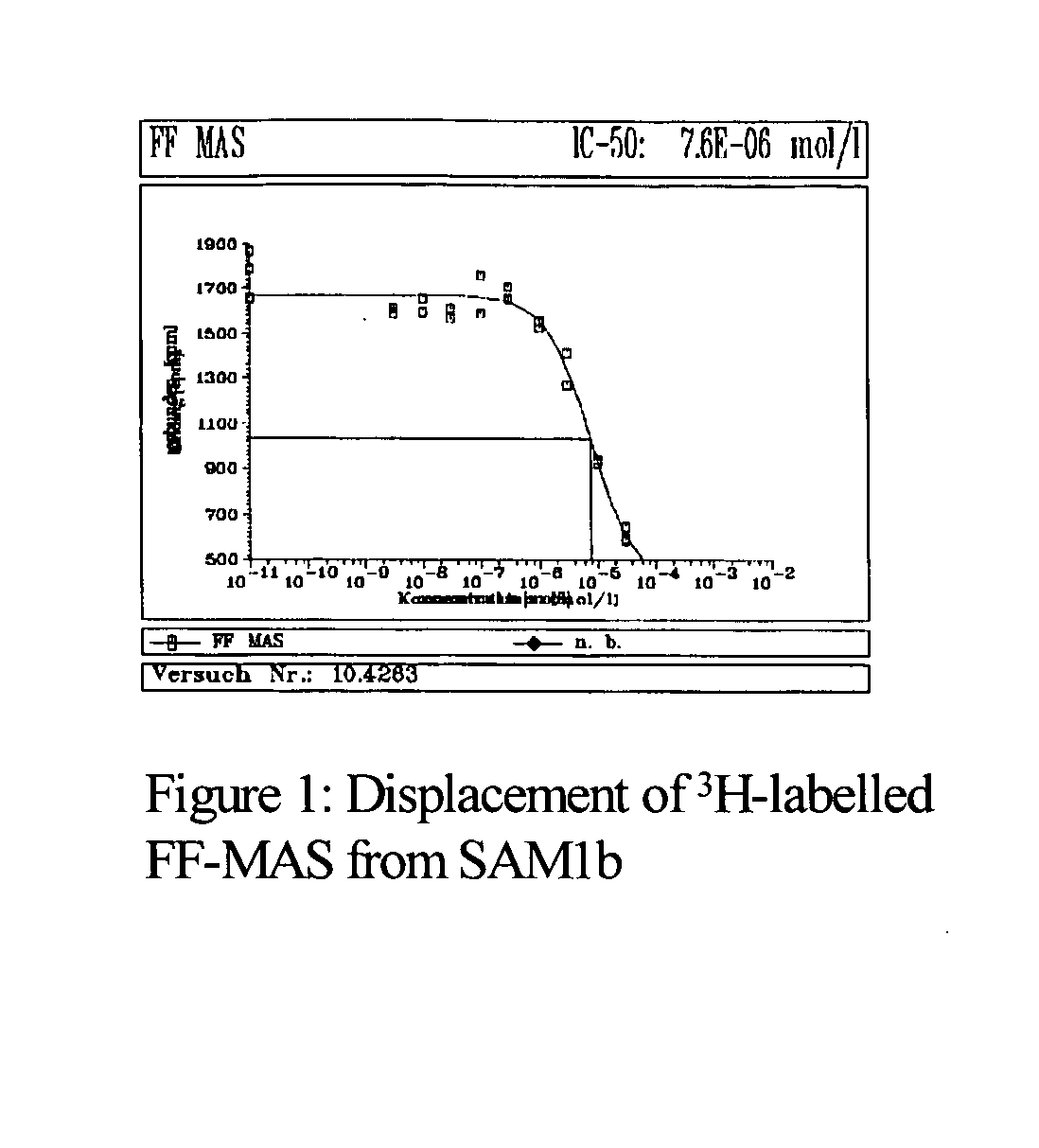Receptors and signalling proteins capable of binding meiotic acting sterols (MAS)
a technology of meiotic acting sterols and receptors, which is applied in the field of receptors or signalling proteins of ffmas, can solve the problems of increasing the overall pregnancy rate, affecting the health of patients and children, and carries the very large side effect of multiple pregnancies with great discomfort and risk, and the increase of health care expenses due to multiple births (twins, triplets etc.) exceeds the entire ivf expenses
- Summary
- Abstract
- Description
- Claims
- Application Information
AI Technical Summary
Benefits of technology
Problems solved by technology
Method used
Image
Examples
example 1
Microinjection of Phosphorothionate Oligonucleotides into Mouse Oocytes
[0069] Two antisense oligonucleotides (20 nucleotides) were utilized for microinjection: 5′-TCCACGATGGACGCCATCTT-3′ and 5′-GCCAGCAGGAGAGCCATTCG-3′, complementary to the kozak sequence of the mRNA encoded by the cDNA sequence herein designated SAM1a and SAM1b, respectively, both of which are defined in SEQ ID NO: 1 and SEQ ID NO: 3, respectively, shown below. In control experiments, the corresponding sense oligonucleotides were microinjected: 5′-AAGATGGCGTCCATCGTGGA-3′ and 5′-CGAATGGCTCTCCTGCTGGC-3′ for mRNA SAM1a and SAM1b, respectively. SAM1a antisense was co-injected with SAM1b antisense from a stock solution containing 1.25 μg / μl of each nucleotide in 10% human serum albumin (hereinafter designated HSA) plus 5 mM Tris (pH value: 7.5). SAM1a sense was co-injected with SAM1b sense from a stock solution containing 1.25 μg / μl of each nucleotide in 10% HSA plus 5 mM Tris (pH value: 7.5). Approximately 12 pg of eac...
example 2
FF-MAS Binding Assay
[0071] 10 μl of the unlabelled FF-MAS (1, 3, 10, 30, 100, 300, 1000, 3000 nM in 6.6% ethanol (EtOH)) was mixed with 10 μl of 200 nM 3H-labelled FF-MAS (approximately 12.8 Ci / mmol) in assay buffer (10 mM Tris; 1.5 mM EDTA; 10% glycerin; 1.0 mM 3-(3-cholamidopropyl)dimethylamino-1-propanesulphonate (hereinafter designated CHAPS, Boehringer Mannheim); 1% BSA (bovine serum albumin)). 10 μg of SAM1b protein freshly diluted in assay buffer, was added to give a final volume of 40 μl. Unspecific binding was measured in the presence of 30 μM unlabelled FF-MAS, total binding was determined by adding 10 μl assay buffer containing 6.6% EtOH. Incubation was performed for 2 hours at 4° C. 250 μl of ice-cold assay buffer containing 2% Cab-osil M-5 (silica gel from Fluka) and 0.2% dextran T70 (Sigma) was added to each tube, mixed and spinned briefly. Approximately 5 minutes after adding Cab-osil M-5, the tubes were centrifuged for 5 minutes, 14000 rpm (minifuge). 200 μl of the ...
example 3
Assay to Determine Whether a Specific Polynucleotide Encodes a Protein which is a MAS Receptor or a MAS Signalling Protein
[0072] 10 μl of the unlabelled FF-MAS (1, 3, 10, 30, 100, 300, 1000, 3000 nM in 6.6% EtOH) is mixed with 10 μl of 200 nM 3H-labelled FF-MAS (approximately 12.8 Ci / mmol) in assay buffer (10 mM Tris; 1.5 mM EDTA; 10% glycerin; 1.0 mM CHAPS; 1% BSA). 10 μg of the specific protein to be tested freshly diluted in assay buffer, is added to give a final volume of 40 μl. Unspecific binding is measured in the presence of 30 μM unlabelled FF-MAS, total binding is determined by adding 10 μl assay buffer containing 6.6% EtOH. Incubation is performed for 2 hours at 4° C. 250 μl of ice-cold assay buffer containing 2% Cab-osil M-5 and 0.2% dextran is added to each tube, mixed and spinned briefly. Approximately 5 minutes after adding Cab-osil M-5, the tubes are centrifuged for 5 minutes, 14000 rpm (minifuge). 200 μl of the supernatant is transferred to a microscint-tube and 3.5...
PUM
| Property | Measurement | Unit |
|---|---|---|
| Molar density | aaaaa | aaaaa |
| Molar density | aaaaa | aaaaa |
| Length | aaaaa | aaaaa |
Abstract
Description
Claims
Application Information
 Login to View More
Login to View More - R&D
- Intellectual Property
- Life Sciences
- Materials
- Tech Scout
- Unparalleled Data Quality
- Higher Quality Content
- 60% Fewer Hallucinations
Browse by: Latest US Patents, China's latest patents, Technical Efficacy Thesaurus, Application Domain, Technology Topic, Popular Technical Reports.
© 2025 PatSnap. All rights reserved.Legal|Privacy policy|Modern Slavery Act Transparency Statement|Sitemap|About US| Contact US: help@patsnap.com

